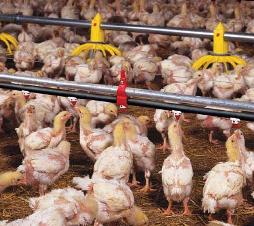Keeping an even pressure in the watering system

Enclosed nipple-type watering systems operate best when the lines are level and parallel to the poultry house floor. However, if the floor slopes, adjustments are needed to avoid the problems associated with high water pressure at the downhill portions of the line. Ziggity has come up with a good solution – the Slope Neutralizer.
By Ad Bal
A watering system that is level and parallel to the floor has the same water pressure throughout the system and each drinker discharges the same amount of water when activated. When the floor slopes, you can either keep the line level or you can have it parallel to the floor. If you keep the line level, some drinkers will be too high for the birds to use. If you keep the line parallel to the floor, the water pressure increases as it gets further downhill from the regulator. When activated, the higher pressure at drinkers downhill from the regulator will cause more water to discharge than the birds can drink. This results in wet litter, ammonia release and disease threats to the flock.
Many farmers have responded to this problem by placing additional specialised regulators along the watering line to keep the pressure consistent. These “slope” regulators are almost identical to the regulators used at the front of the line. There is only one difference – the slope regulators have two riser tubes, one for measuring incoming pressure and the other for outgoing pressure. Although this solution works, it has disadvantages:
• It is expensive, and the cost of installing the additional slope regulators is substantial.
• Adjustments of each regulator are necessary every time the water pressure is changed. This is labour intensive.
• The slope regulators make high-pressure line flushing impossible, thereby leaving the watering lines susceptible to biofilm growth, posing additional health threats to the flock.
Simple solution
Ziggity has found a solution to this problem, called a “Slope Neutralizer”, which functions quite differently than a regulator. To understand this, one must understand the way a regulator works.
An adjustment knob, generally found on the bottom of the regulator, allows you to regulate the water pressure in the watering system. The pressure is measured in column height, according to how high water stands in the riser tube. The knob is attached to a spring that puts pressure on a diaphragm.
The diaphragm, in turn, controls the inlet valve, which functions to allow water to enter the watering system. When a drinking line is fully charged and level, the water pressure is consistent from the regulator all the way to the other end of the line. At the same time, the spring’s upward pressure against the diaphragm and the downward water system pressure are equal and the inlet valve is closed.
Water is drawn from the system as the birds drink, and the water pressure on the outlet side of the regulator is slightly reduced. Pressure exerted by the spring forces the diaphragm up to compensate for the reduced water pressure, and this opens the inlet valve enough to allow in more water, bringing the system back to the correct pressure. This action takes place almost continuously as the birds drink.
Steel balls
The Slope Neutralizer works differently. In order for water to discharge from the Slope Neutralizer’s outlet side, it must lift two stainless steel balls off valve ‘seats’ that separate the inlet from the outlet chambers. This requires about3.5 – 4 column inches (9 – 10 cm) of pressure to do so. That, in effect, means that if the column pressure coming into the slope neutralizer is 10 inches (25 cm) then the water pressure leaving the neutralizer is about 6 inches (15 cm). The Slope Neutralizer gives a number of advantages:• First and foremost, it costs considerably less than a regulator.
• The neutralizer reduces built-upslope pressure by a set amount, about4 inches column height (10 cm).
•The neutralizer requires no permanent adjustment. When you change the pressure settings at the regulator, the Slope Neutralizer automatically increases or decreases its outgoing pressure by the same amount.
• The neutralizer allows for high pressure flushing to clean the lines of sediment and biofilm.
Listen to the manufacturer
Using Slope Neutralizers requires a poultry farmer to carefully set up the watering system according to the manufacturer’s instructions. You should always locate the regulator at the high end of the line. Water always flows downhill, so never try to push water uphill. Bare in mind that a Slope Neutralizer with a 4 inch (10 cm) pressure reduction must be mounted where 4 inches (10 cm) of fall (from the regulator or another Slope Neutralizer) is present in the line. Mounting the neutralizers either too far uphill or downhill from the appropriate point will diminish their effectiveness.













